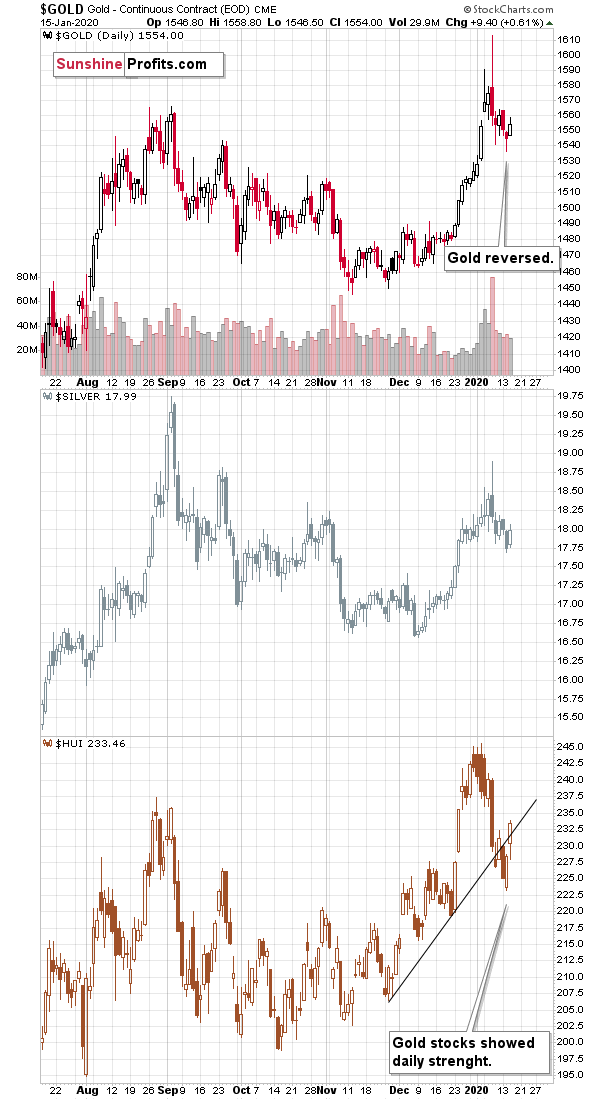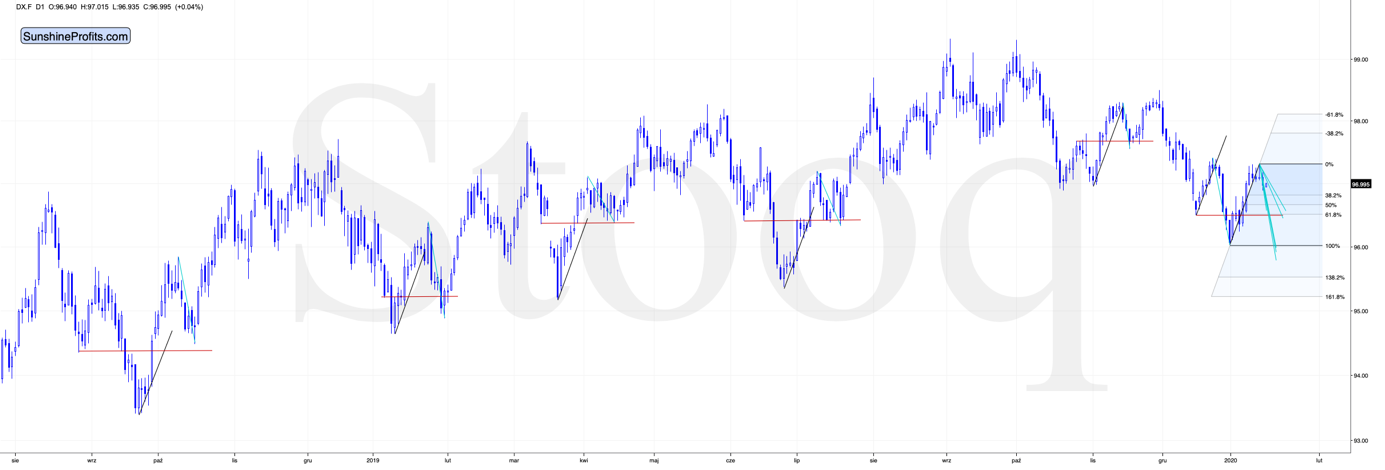Briefly: in our opinion, no speculative short positions in gold, silver, and mining stocks are justified from the risk/reward point of view at the moment of publishing this Alert.
Yesterday at 7:48 EST we published the Alert in which we wrote about closing the short positions. In the subsequent 30 minutes, gold and silver moved lower and bottomed at about $1,548 and $17.76, respectively. The GDX ETF - proxy for mining stocks - declined a bit after opening, but ultimately ended the session almost 2% higher. In short, it's good that we closed the short positions before yesterday's upswing.
Of course, it doesn't mean that the medium-term outlook changed, or that the points made in Monday's extensive Alert were invalidated. Conversely, the key points remain up-to-date and the medium-term outlook (for the following 6-12 months) remains extremely bearish.
However, at the same time, the bullish points that we made yesterday with regard to the short term (the next several days) remain up-to-date as well. Gold was likely to move higher based on its reversal, relative strength in gold stocks and - most importantly - based on the likelihood of seeing a pullback in the USD Index. And it did.
The question now is how high are gold, silver, and mining stocks likely to rally before they top and resume their decline. In yesterday's analysis, we already wrote that the upside targets are rather vague:
We definitely don't expect gold, silver, or miners to move to new 2020 highs based on this corrective upswing, but they could erase 38.2% - 61.8% of the January decline before their move lower resumes. In case of gold miners, we could simply see a comeback to the previously broken rising red support line and a local top at or very close to it.
Precious Metals Reverse
The situation with regard to specific short-term price targets for gold, silver, and miners is now even less precise, because the HUI Index invalidated the breakdown below the rising support line instead of topping at or below it. This indicates further short-term (!) strength.
Gold seems to have reversed yesterday, and silver moved lower in today's pre-market trading, which only adds to the short-term uncertainty.
Fortunately, the USD Index might provide us with clues that are not visible when looking at the PMs alone.
Since the odds for a pullback in the USD Index increased substantially based on the time that it had been rallying without a correction - and it worked - then applying time analysis to the previous pullbacks should provide us with some insights.
Moreover, let's keep in mind that gold tends to rally the most in the final part of the USDX's downswing. So, if the latter has only begun, and that is likely the case, then the upside potential for gold is still present.
Also, please note that miners just rallied strongly while silver was only moderately strong. That's what's characteristic in the early parts of upswings, not in its final days and that's something that we can observe in both long- and short-term moves.
So, does the greenback really have more to decline based on how the previous pullbacks looked like?
USDX Prospects
Yes.
In most cases, the USD Index corrected between 38.2% and more than 61.8% of the preceding rallies, but it didn't move to new lows. Of course, this assumes that the final bottom for the USDX is already in, but this is very likely the case based on its long-term situation (you will find details in Monday's analysis).
The corrections usually ended at previous support or resistance levels provided by some kind of price extreme or price gap. We marked those cases with red.
We also copied the previous pullbacks to the current situation (marked with light blue).
If we ignore the cases when the USDX moved below the previous lows, we are left with the ones that took it to the area corresponding to between the 50% and 61.8% Fibonacci retracements. This seems to be the most likely target area for the current pullback, especially that the 61.8% retracement corresponds to the December low.
As far as the shape of the recent price moves is concerned, it's most similar to what we saw in October 2018 and July 2019. In both cases, the USDX bottomed very close to the previous lows.
So, while the price targets for gold, silver, and miners are unclear, we can still design a strategy for getting back into short positions at or close to the upcoming highs. The strategy is looking for topping confirmations from the precious metals market, while the USD Index moves below its 50% Fibonacci retracement level (by another 0.3 - 0.4 index point). Naturally, we will keep you - our subscribers - informed.
Summary
Summing up, even though the medium-term outlook for the precious metals sector remains extremely bearish, the odds are that we will see a few more days of a corrective upswing. We plan to wait out the correction on the sidelines and get back into the market at a more favorable risk to reward point. While the price targets for gold, silver, and mining stocks are rather unclear, the link with USD Index and the situation in the latter allow for implementing a strategy aimed at getting back to the short position close to the next local high.
As always, we'll keep you - our subscribers - informed.
To summarize:
Trading capital (supplementary part of the portfolio; our opinion): No positions
Long-term capital (core part of the portfolio; our opinion): No positions (in other words: cash)
Insurance capital (core part of the portfolio; our opinion): Full position
Whether you already subscribed or not, we encourage you to find out how to make the most of our alerts and read our replies to the most common alert-and-gold-trading-related-questions.
Please note that the in the trading section we describe the situation for the day that the alert is posted. In other words, it we are writing about a speculative position, it means that it is up-to-date on the day it was posted. We are also featuring the initial target prices, so that you can decide whether keeping a position on a given day is something that is in tune with your approach (some moves are too small for medium-term traders and some might appear too big for day-traders).
Plus, you might want to read why our stop-loss orders are usually relatively far from the current price.
Please note that a full position doesn't mean using all of the capital for a given trade. You will find details on our thoughts on gold portfolio structuring in the Key Insights section on our website.
As a reminder - "initial target price" means exactly that - an "initial" one, it's not a price level at which we suggest closing positions. If this becomes the case (like it did in the previous trade) we will refer to these levels as levels of exit orders (exactly as we've done previously). Stop-loss levels, however, are naturally not "initial", but something that, in our opinion, might be entered as an order.
Since it is impossible to synchronize target prices and stop-loss levels for all the ETFs and ETNs with the main markets that we provide these levels for (gold, silver and mining stocks - the GDX ETF), the stop-loss levels and target prices for other ETNs and ETF (among other: UGLD, DGLD, USLV, DSLV, NUGT, DUST, JNUG, JDST) are provided as supplementary, and not as "final". This means that if a stop-loss or a target level is reached for any of the "additional instruments" (DGLD for instance), but not for the "main instrument" (gold in this case), we will view positions in both gold and DGLD as still open and the stop-loss for DGLD would have to be moved lower. On the other hand, if gold moves to a stop-loss level but DGLD doesn't, then we will view both positions (in gold and DGLD) as closed. In other words, since it's not possible to be 100% certain that each related instrument moves to a given level when the underlying instrument does, we can't provide levels that would be binding. The levels that we do provide are our best estimate of the levels that will correspond to the levels in the underlying assets, but it will be the underlying assets that one will need to focus on regarding the signs pointing to closing a given position or keeping it open. We might adjust the levels in the "additional instruments" without adjusting the levels in the "main instruments", which will simply mean that we have improved our estimation of these levels, not that we changed our outlook on the markets. We are already working on a tool that would update these levels on a daily basis for the most popular ETFs, ETNs and individual mining stocks.
Our preferred ways to invest in and to trade gold along with the reasoning can be found in the how to buy gold section. Additionally, our preferred ETFs and ETNs can be found in our Gold & Silver ETF Ranking.
As a reminder, Gold & Silver Trading Alerts are posted before or on each trading day (we usually post them before the opening bell, but we don't promise doing that each day). If there's anything urgent, we will send you an additional small alert before posting the main one.
Thank you.
Sincerely,
Przemyslaw Radomski, CFA
Editor-in-chief, Gold & Silver Fund Manager





